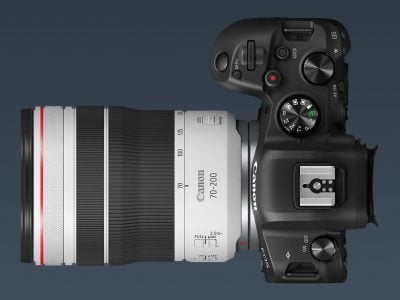Canon RF 70-200mm f4L IS USM review
-
-
Written by Gordon Laing
Intro
The Canon RF 70-200mm f4L IS USM is a compact telephoto zoom for the EOS R mirrorless system. It uses an extending barrel that makes it comfortably shorter and more transportable than the previous EF version. Announced in November 2020, it comes just over two years after the previous EF 70-200mm f4L IS II USM and costs roughly 50% more, albeit about one third less than the RF f2.8 model.
The new RF 70-200mm f4L model follows a similar strategy to the RF f2.8L, employing an extending barrel to become much shorter at the 70mm focal length. When both lenses are zoomed to 200mm, the new lens almost exactly matches the length of the fixed EF model, but when set to 70mm, the new RF model shrinks down to just 119mm long. Weighing 695g, it’s almost 100g lighter too and works out roughly similar in size and weight to the RF 24-105mm f4L, or little larger than a 330ml drinks can. In my in-depth review below I’ll directly compare the RF 70-200mm f4L against the previous EF Mark II version, as well as the high-end RF 2.8L model. So if you’re looking for a telephoto zoom for your EOS R camera, you’ve come to the right place! PS – if you prefer to read a written version, keep scrolling…
Check prices on the Canon RF 70-200mm f4L IS USM at B&H, Adorama, WEX or Calumet.de! Alternatively get yourself a copy of my In Camera book or treat me to a coffee! Thanks!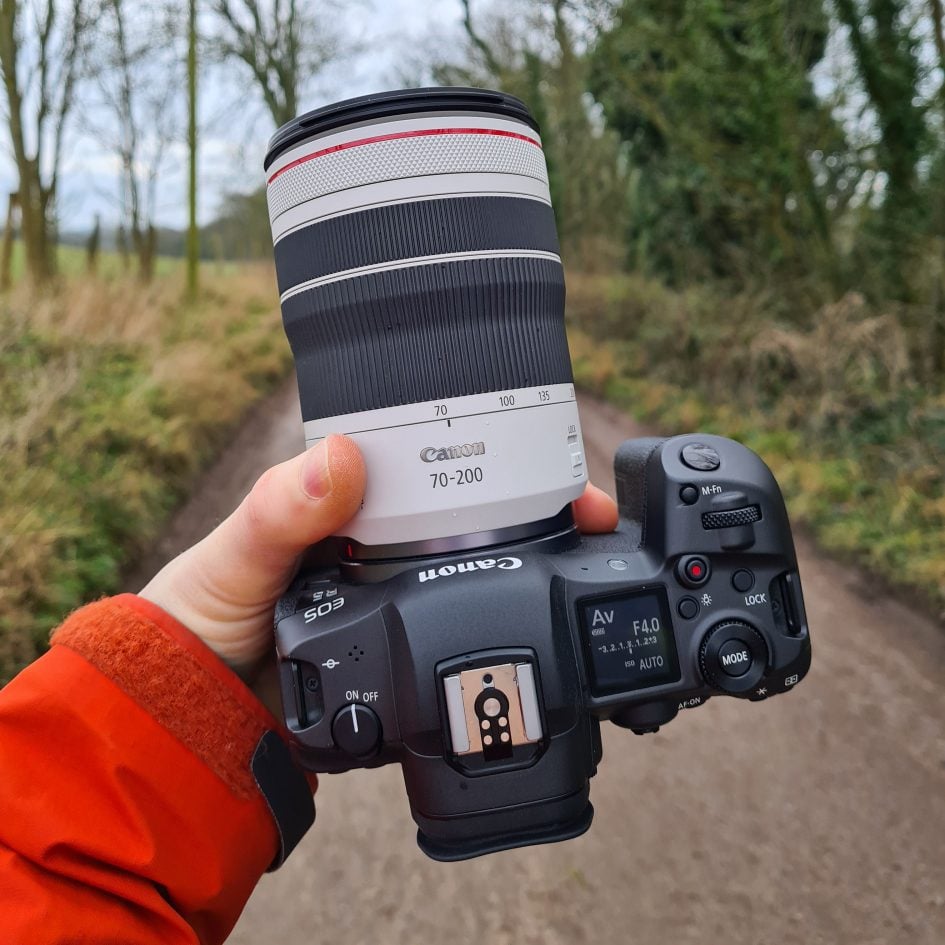
Above: The RF 70-200mm f4L follows a similar strategy to the RF 2.8, employing an extending barrel to become much shorter at the 70mm focal length. This is in contrast to the previous EF 70-200’s which employed fixed barrels with internal zooming.
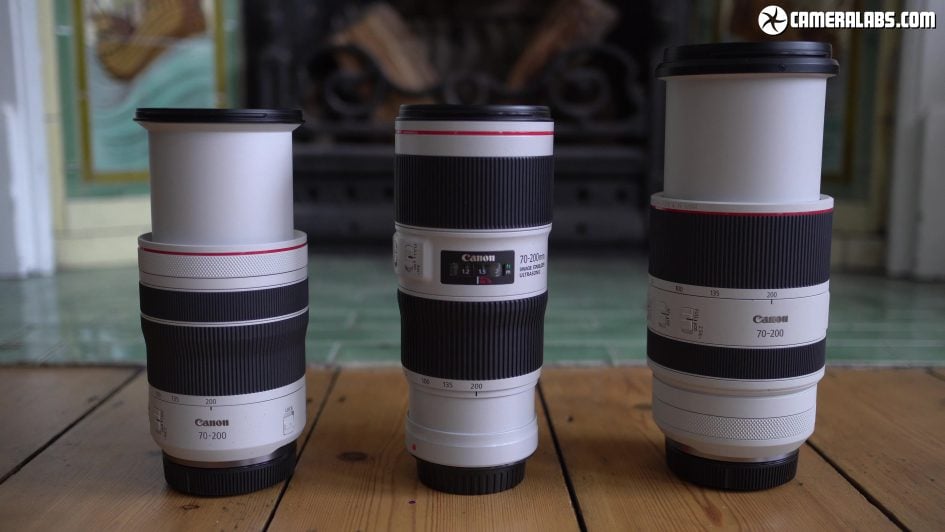
Above: Ok so how much smaller are we talking? Here’s the most recent EF 70-200mm f4L Mark II in the middle, set to 200mm, joined by the RF 70-200mm f4L on the left, also set to 200mm – notice how they’re almost the same length when zoomed to 200mm, and for good measure, the RF 70-200mm f2.8L on the right, also zoomed to 200mm where it’s a couple of cm longer.
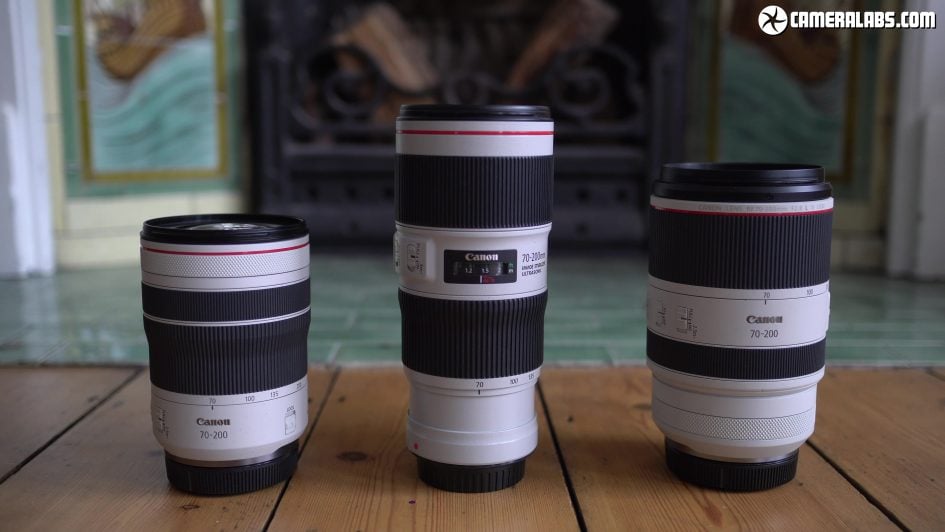
Above: So far so similar, but unlike the internal zoom on the EF model in the middle, the two RF lenses flanking it employ extending barrels which retract when zoomed to 70mm. So with all three lenses now set to 70mm, notice how the two RF lenses have shrunk considerably, compared to the older EF lens which has of course stayed exactly the same size.
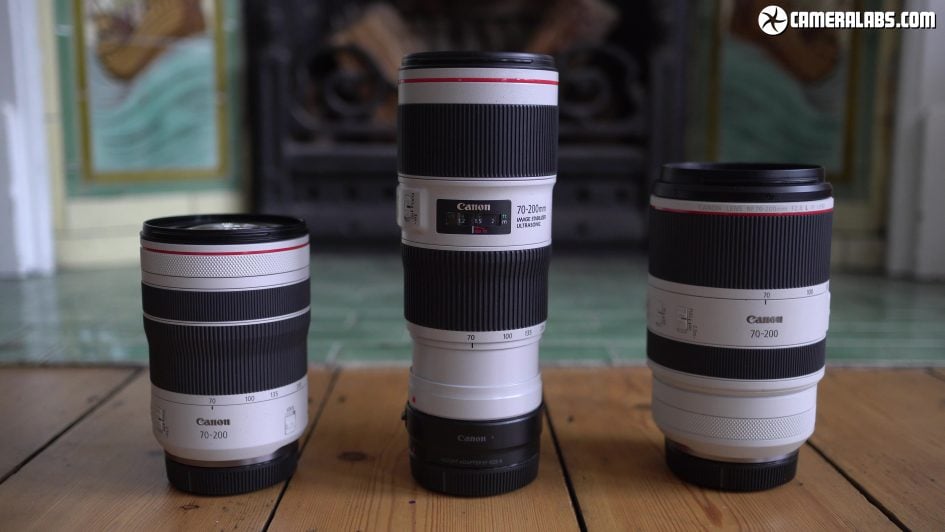
Above: The difference becomes even greater when you fit the adapter required to mount the EF lens on an EOS R body. Note neither of the RF 70-200s are compatible with the RF teleconverters.
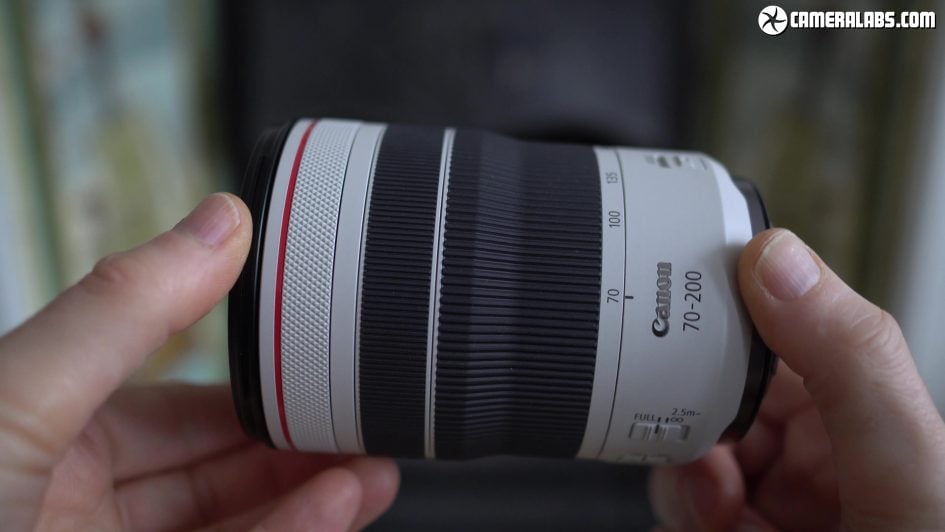
Above: When extended, the RF 70-200mm f4L measures 176mm long, but shrinks to just 119mm at the short-end of the range, where a switch can also lock it in place for transportation.
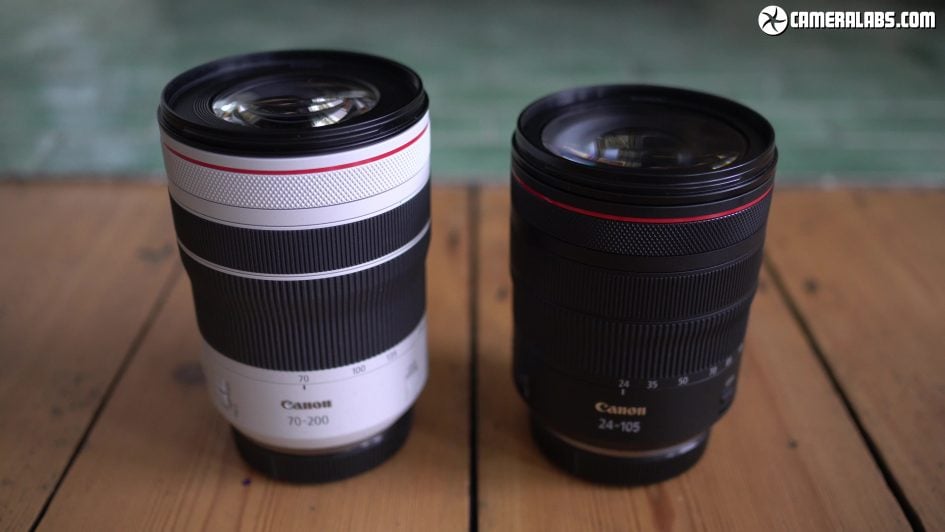
Above: Weighing 695g, the RF version is also almost 100g lighter than the EF model (not including the adapter either) and works out roughly similar in size and weight to the RF 24-105mm f4L seen here on the right.
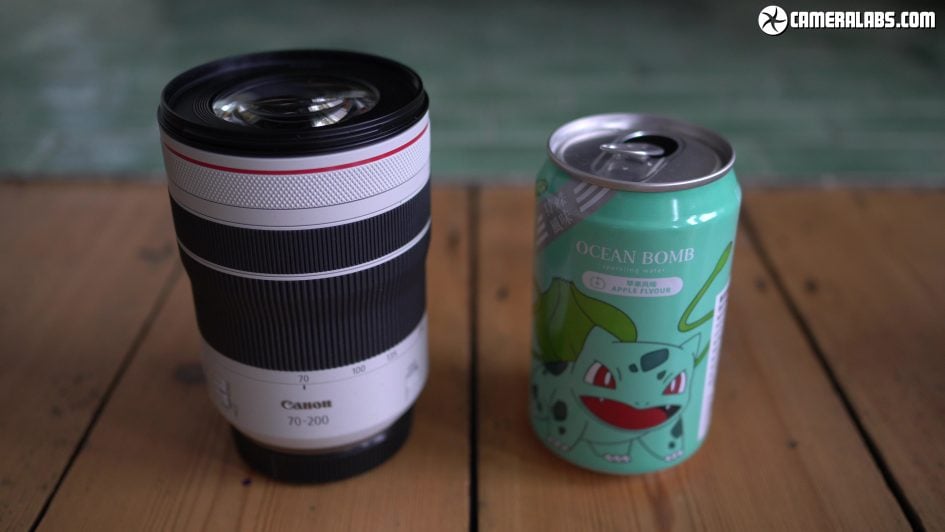
Above: Indeed, measuring little more than a standard 330ml can, you’ll be able to accommodate it in smaller bags, even standing up, whereas the sheer length of the older lens means it normally has to be laid down flat in a bag. Extending barrels may allow more compact designs, but introduce the risk of dust and moisture entering the system. Canon’s employed various air filters in vulnerable areas to allow air to pass, but no unwanted particles, and both of the RF 70-200’s are described as being weatherproof. Now I’ve only used them for a few weeks at a time so can’t yet say how effective they’ll be long-term – only time will tell. But if you are concerned or simply interested in the build, I can highly recommend the Lens Rentals teardown article on the RF 2.8 model which shows what’s going on inside, revealing a very reassuring degree of build quality.
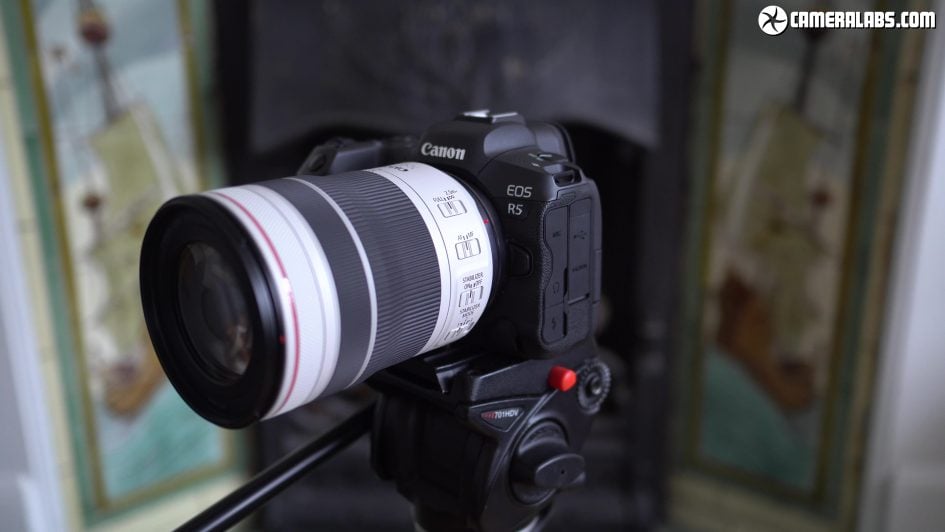
Above: In terms of materials, the RF 70-200mm f4L employs engineering plastic for its barrel rather than the mix of metal and plastic for the EF version. Again I’ve not dropped or banged either lens, so can’t say whether one’s tougher than the other, but don’t assume metal wins for this kind of job. Canon’s adopted engineering plastics for all of its RF lenses so far without issues.
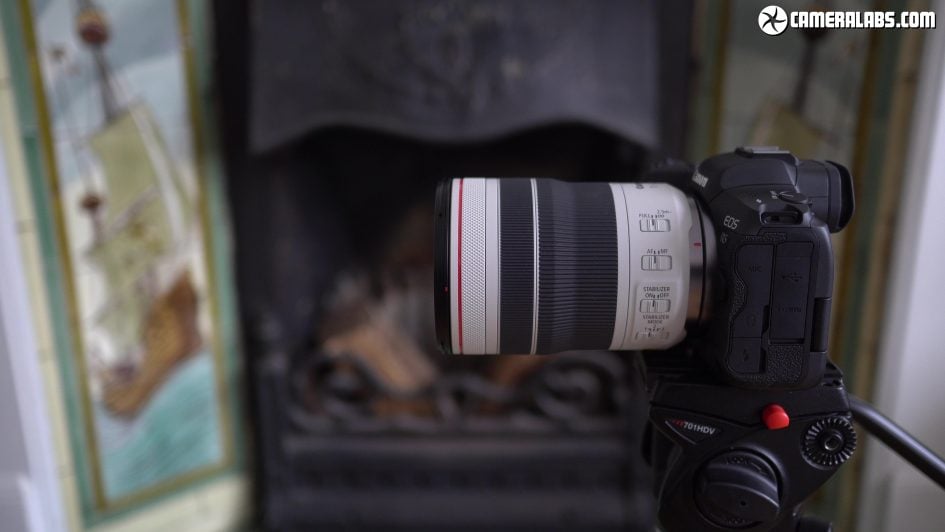
Above: In terms of controls, the RF 70-200mm f4L has a wide zoom ring which feels smooth, but requires a stronger twist than the zoom on the older EF version. Next to this is a thin manual focusing ring that like most native mirrorless lenses, employs a motor-assisted approach. Then at the end of the barrel is the customisable RF clicky control ring.
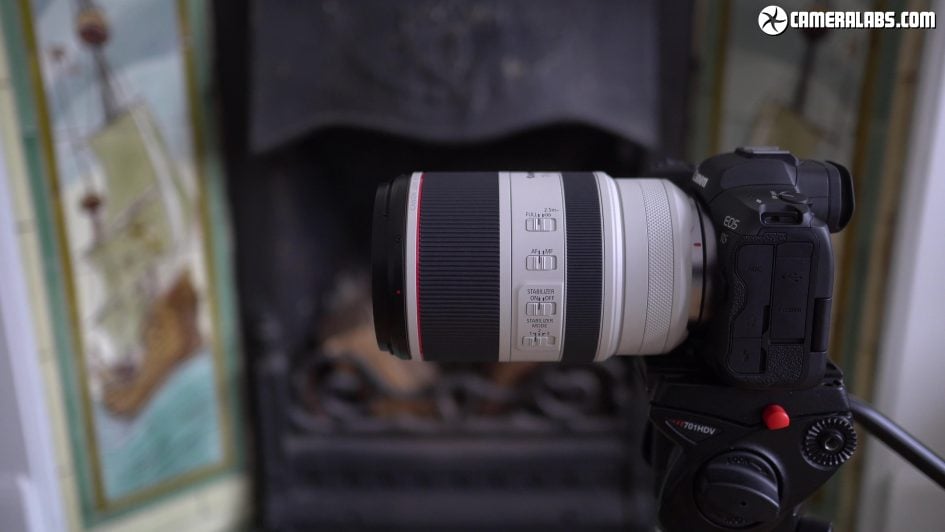
Above: Interestingly the RF f2.8L model seen here positions its control ring closest to the lens mount and swaps the position of the focus and zoom rings.
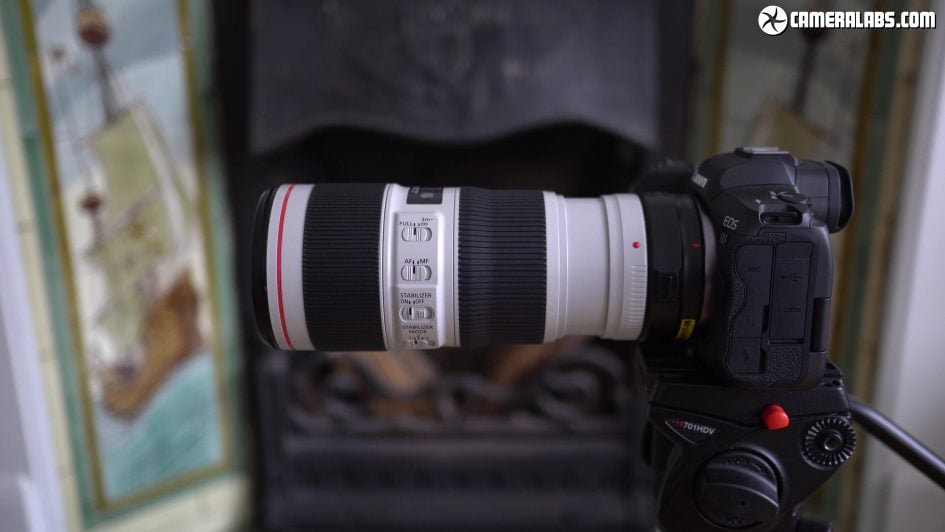
Above: For comparison, here’s the older EF 70-200mm f4L again showing its length, further increased by the adapter. Note the looser-feeling zoom ring and the wider manual focusing which is mechanically-linked while also showing focus distance in a window, while the RF lenses display it graphically on-screen.
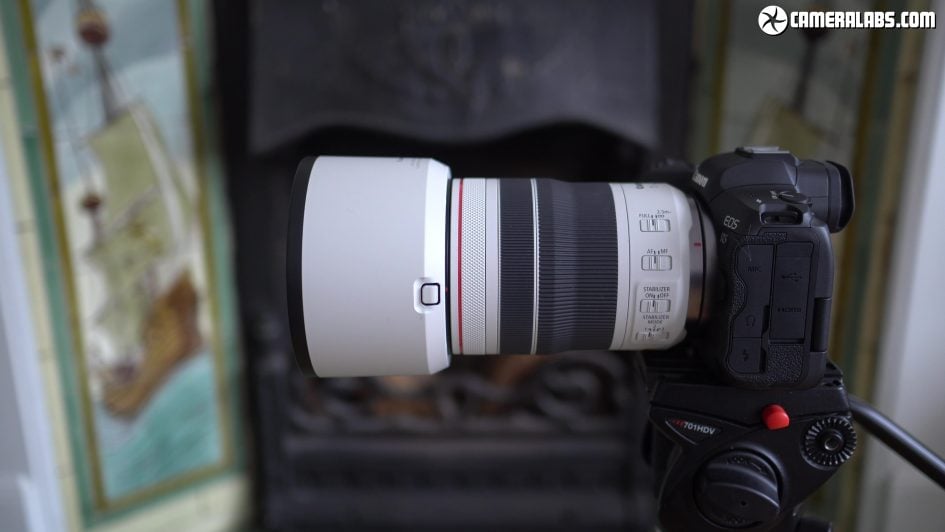
Above: The RF 70-200mm f4L employs a 77mm filter thread – matching the f2.8 version but larger than the 72mm thread on the EF 70-200mm f4L, and as L lenses, all three are supplied with hoods. Canon’s opted to supply its big white RF zooms with matching white hoods, unlike the black hood on the EF model. Note the RF 70-200 f4 hood lacks the sliding window of the 2.8 version to access rotating filters. A more notable difference is the absence of a tripod collar mount on the RF 70-200 f4L, versus the f2.8 version and indeed the older EF 70-200mm f4, both of which are supplied with detachable collars with feet for tripods – that said, the RF 70-200 f4 is sufficiently small and light not to really need one and I had no issues mounting it on even modest tripods.
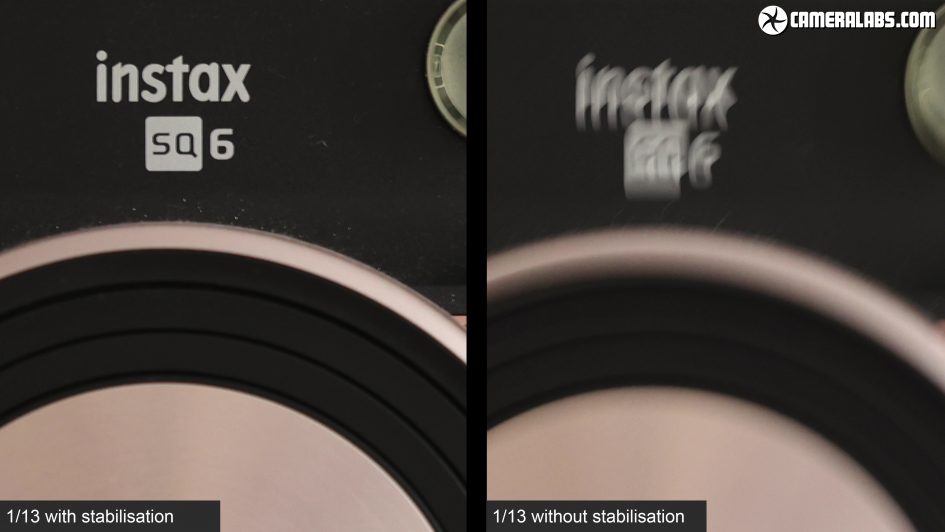
Above: Like the EF model, there’s four switches on the side of the barrel including a focus limiter that operates between 2.5m and infinity. There’s three IS modes and Canon claims the optical stabilisation provides up to five stops of compensation on bodies without IBIS, or up to 7.5 on bodies with IBIS. To put it to the test I took a series of photos at steadily slower shutter speeds with the RF 70-200mm f4L at 200mm on an EOS R5 body which has IBIS. With both IBIS and optical stabilisation enabled, I could handhold a mostly sharp result at 13th of a second and you can see it here versus the same shutter speed with all stabilisation disabled. For a sharp result on the R5 without stabilisation enabled, I needed a shutter speed of at least 1/200, which meant I was experiencing around four stops of compensation. I reshot the test using the older EF 70-200mm f4L on the R5 and measured almost identical results, so personally speaking I only achieved around four stops of compensation with either lens and didn’t come near to the quoted 7.5 stops for the new lens.
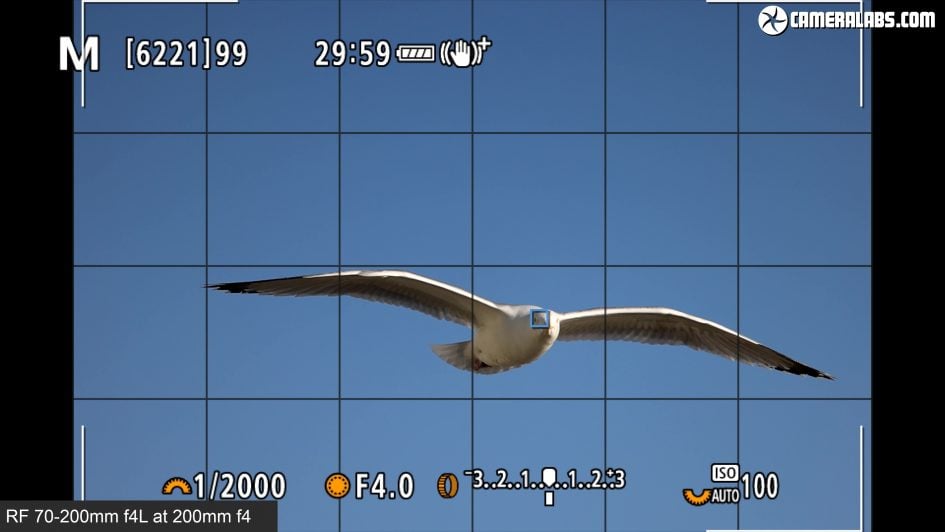
Above: Moving onto autofocus, the RF 70-200 f4L employs dual Nano USM motors, allowing it to focus closer than the old EF version as well as operating more smoothly and quietly. In my tests – demonstrated in the video review above – the RF version focused a little faster than the EF model and felt more confident too, whether photographing objects, people or wildlife.
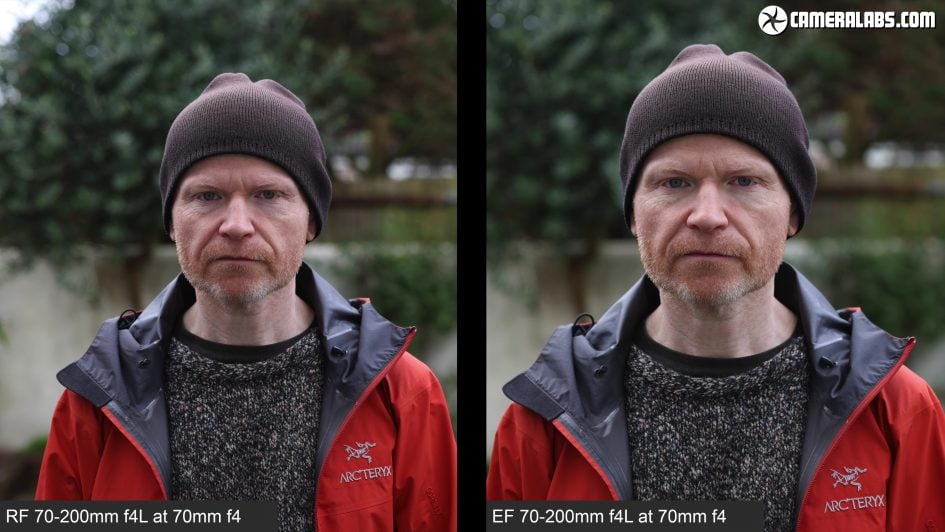
Above: Portraiture is of course bread and butter for telephoto zooms, so let’s make a few comparisons, starting with the lenses at 70mm, and the first thing you’ll notice is a slightly tighter field of view from the older EF version when used for close subjects at the same distance. I’ll talk about that more in a moment, but for now try to look past the magnification differences. Side by side with the RF on the left and the EF on the right I’d say the RF is a tad crisper on the finest details, but equally is arguably a tad less creamy on the rendering in the background.
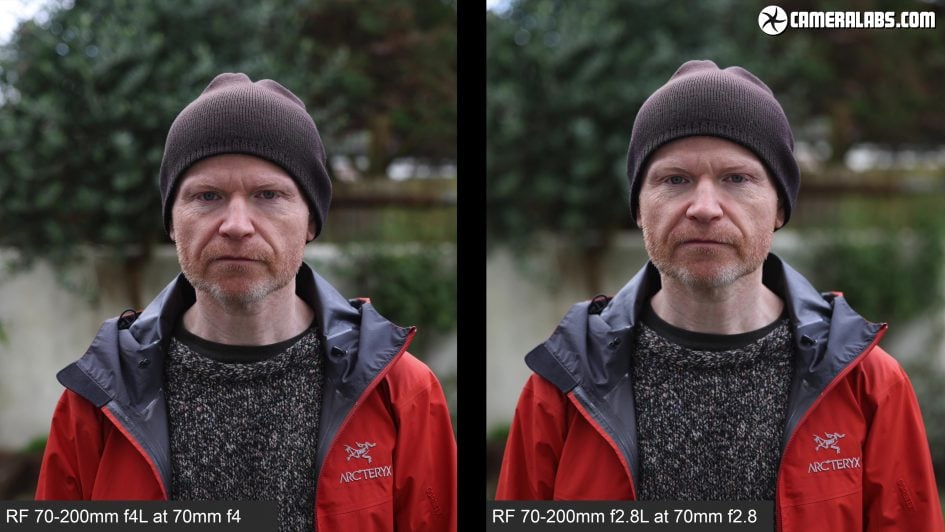
Above: Now let’s swap the EF on the right for the RF 70-200mm f2.8, first at 70mm f2.8, where you can see the benefit of that extra stop of aperture in delivering a shallower depth of field with greater background blur. Is there a big enough difference to justify the extra cost and weight?
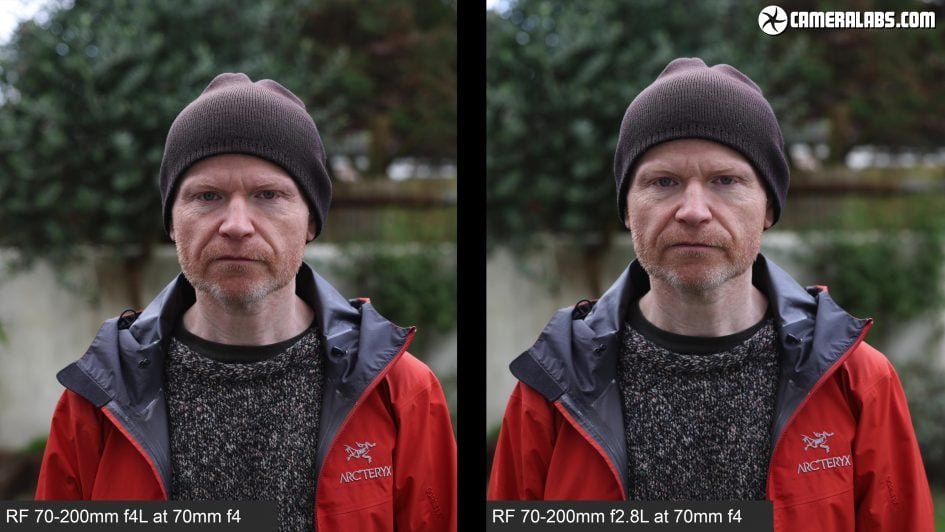
Above: And now for the RF 70-200mm f2.8 closed one stop to f4 to match the cheaper model. Now the size of the bokeh blobs are similar, but the f2.8 model is rendering them with smoother edges for a less busy effect, even at f4. I’d say it’s preferable, but again you’re paying a premium in price and carrying a heavier lens. The bottom line is all three of these lenses are razor sharp on subject details.
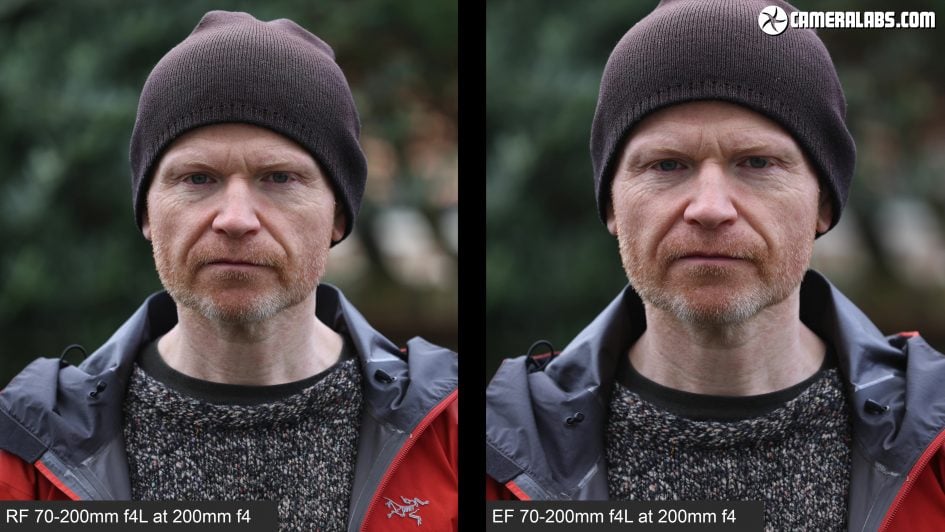
Now for them at 200mm where it’s possible to really blur the background on portraits. Side by side with the RF on the left and the EF on the right, the latter’s slightly greater magnification obviously means again the bokeh blobs are larger, but looking beyond this and I’d say they’re still a little smoother and softer-edged on the older EF model, but that the newer RF lens is delivering crisper details.
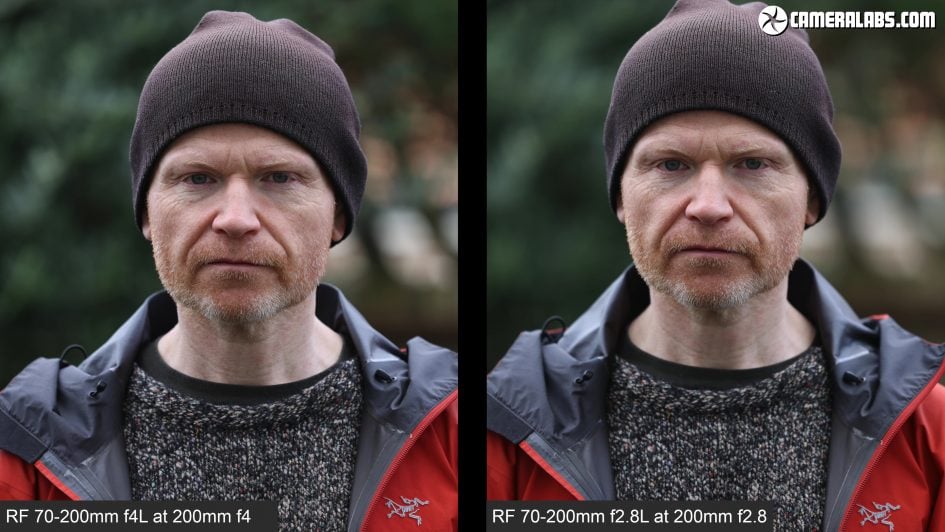
Above: Now let’s switch the EF lens on the right for the RF 70-200mm f2.8L at 200mm f2.8, and again you’ll see the benefit of the shallower depth-of-field for providing greater subject separation, and as before, the edges look a little smoother from this lens than the f4 model on the left.
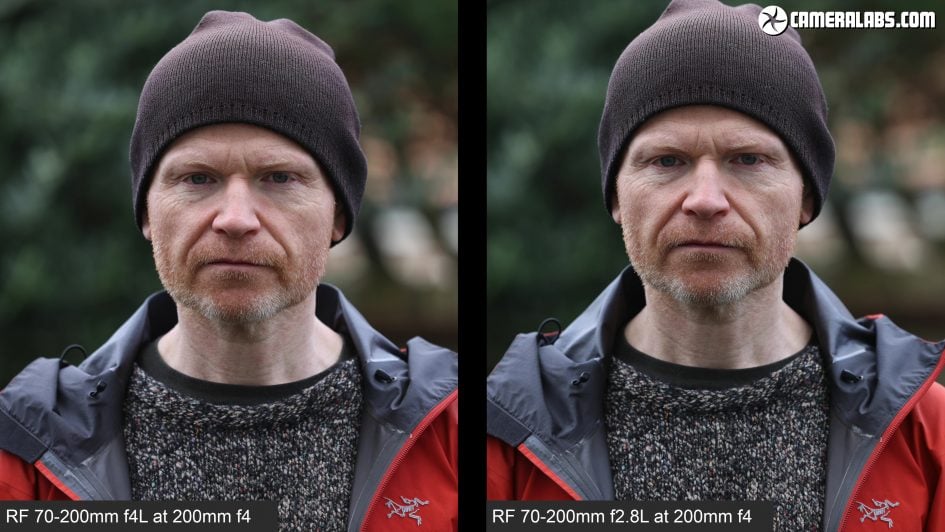
Above: And finally, closing the f2.8 lens on the right to f4 brings the size of the blurring to a similar level, but again I’d say the f2.8 model on the right is enjoying smoother edges for a less distracting background. So not only does the RF 2.8L version boast an extra stop of aperture for shallower depth of field effects, but I’d say its rendering of blurred areas is softer too, making it ultimately more desirable. Both RF lenses are tremendously sharp though throughout their focal ranges.
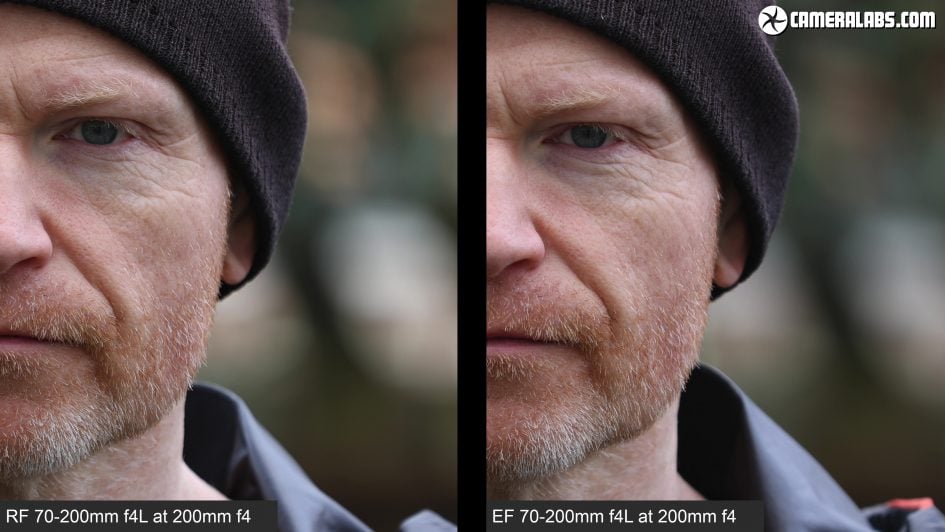
Above: As for the older EF Mark II lens, it’s still a fantastic performer as you’d expect for a fairly recent release. But during my tests I found the R5’s eye detection didn’t always drive it as consistently or accurately as it did with native RF lenses. I’ve noticed this with some other adapted EF lenses and if you’re manually focusing you might enjoy fractionally superior results, but from my experience when autofocusing with an EOS R body, you’ll enjoy a higher hit rate with greater accuracy and consistency with native RF lenses than adapted EF ones.
Before moving on, I wanted to address that difference in magnification, due to an effect known as focus breathing and we’ve seen it before when comparing the RF 70-200mm f2.8L against the EF version of that lens. As the RF 70-200’s focus closer, their coverage broadens as if you’re zooming the lens to a wider focal length.
Compare it to the older EF 70-200mm f4L and it too suffers from focus breathing but with an opposite effect where the coverage becomes tighter as you focus closer, as if you’re zooming the lens to a longer focal length. What this means is the newer RF lenses deliver lower magnification as they focus closer, so the effect is most noticeable on portraits and macro. You’re still getting a 2.85x optical range from the short to the long end, but the effective focal lengths become shorter, maybe closer to a 50-150 than a 70-200. So if you already own a 135 lens, then the RF 70-200s aren’t going to make much difference in magnification at portrait distances. But if you don’t own a lens in this range, or have something to compare it against, you’re unlikely to notice.
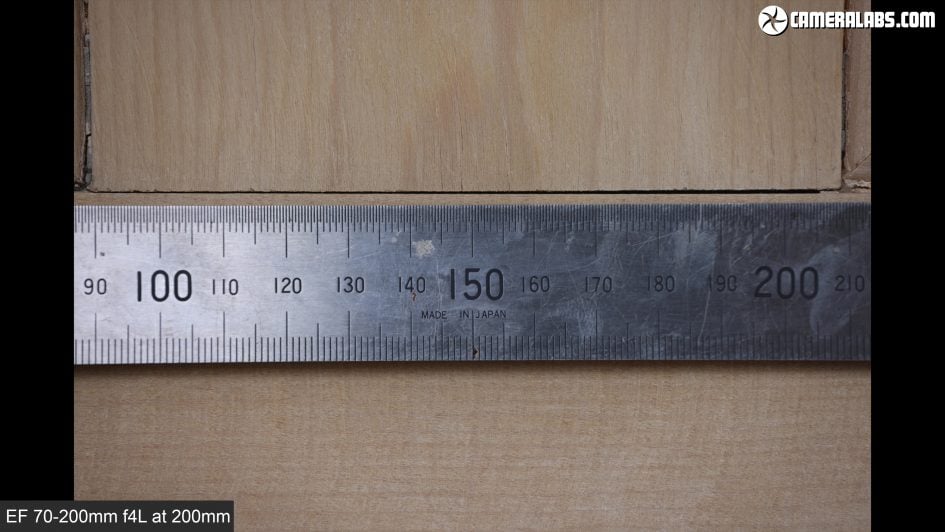
Above: To illustrate the worse-case scenario, here’s the older EF 70-200mm f4L zoomed to 200mm and positioned as close as it can focus to a ruler, approximately 1m from the focal plane.
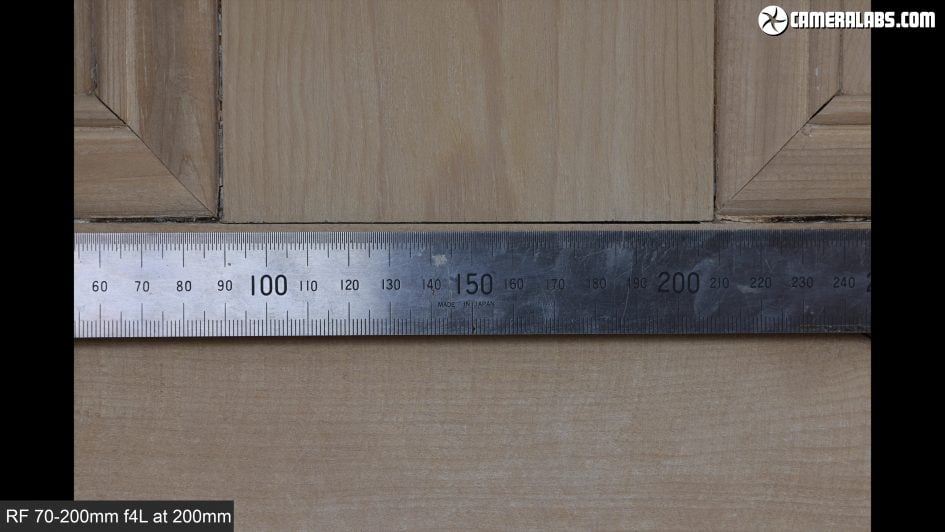
Above: And now for the RF 70-200mm f4L again at 200mm and from exactly the same distance where the difference in magnification is quite striking. But the new RF lens can focus much closer, down to 60cm from the focal plane.
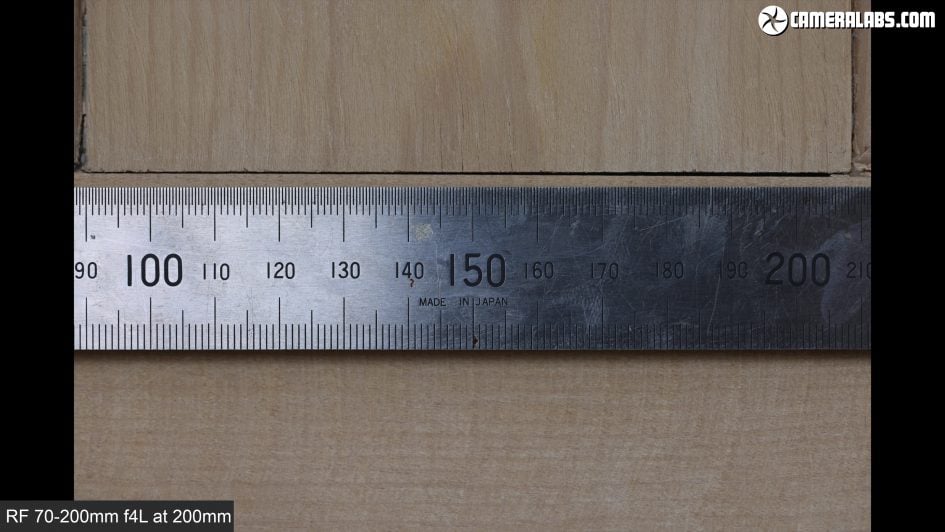
Above: so here it is now from its own closest focusing distance where if I toggle between the two lenses, you’ll see the newer RF model actually delivering almost the same coverage, in fact a fraction tighter.
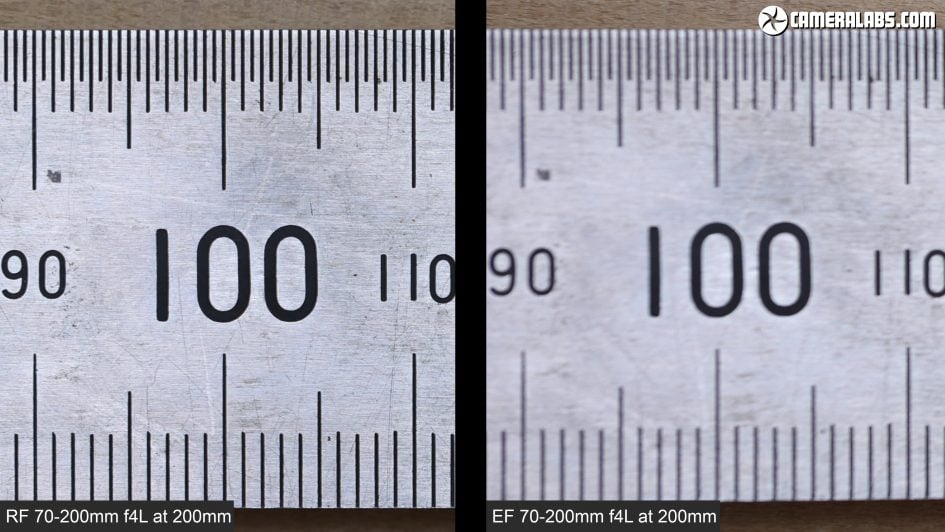
Above: More importantly if you look closer, you’ll see the RF lens is much sharper at its closest focusing distance than the EF model, especially at the edges, so in terms of quality at close range it represents an upgrade, but don’t expect much or even any difference in magnification at their respective closest distances.
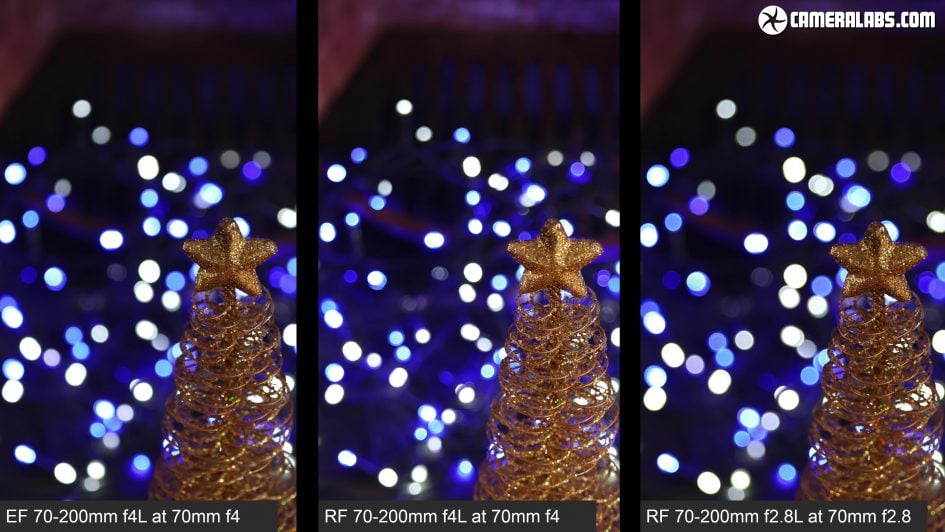
Above: Ok, now onto bokeh as the rendering of blurred areas is an important factor in a lens designed for portraits, events and close-range sports or wildlife. Let’s take a closer look at the rendering at 70mm using their maximum apertures. Since all were shot from the same distance, the EF is showing bigger magnification, so for a side-by-side I’ve cropped-in a little on the RF images to match the coverage. So here we have the EF 70-200mm f4 on the left, the RF 70-200mm f4 in the middle, and the RF 70-200mm f2.8 on the right, all at their maximum apertures. There’s no right or wrong here in terms of style, just personal preference, but the RF 70-200mm f4L in the middle is rendering sharper edges.
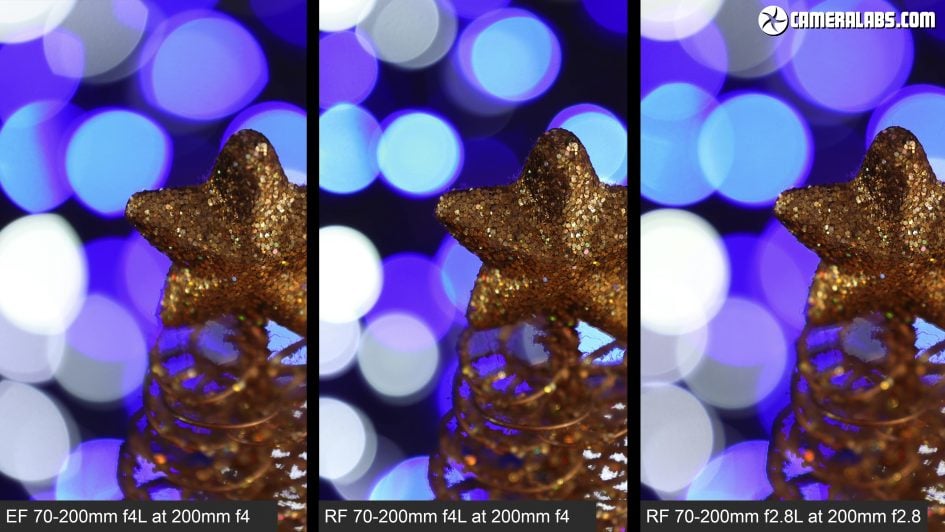
Above: Now for them all at 200mm and using their maximum apertures, starting with the RF 70-200mm f4, followed by the RF 70-200mm f2.8 and finally the EF 70-200mm f4. Again with their coverage matched by cropping the RF images, with the EF 70-200mm f4 on the left, the RF 70-200mm f4 in the middle, and the RF 70-200mm f2.8 on the right, again all at 200mm and all at their maximum apertures. Do you have a preference? I quite like the softer edges on the older EF lens and the RF 2.8 models, but all look pretty good.
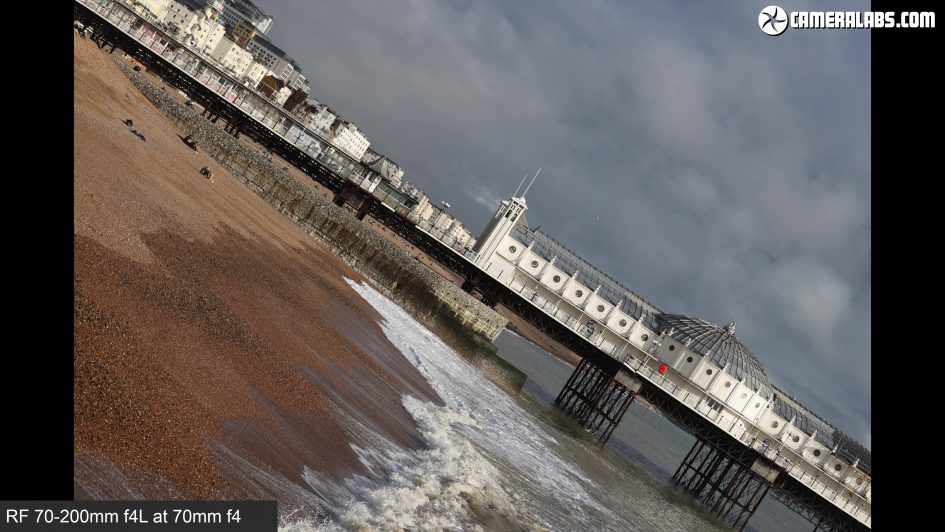
Above: In my final test I’ll compare the RF 70-200mm f4L against the EF version with a distant subject and I’ve angled the camera so fine detail extends into the corners. I’m starting here with the RF 70-200mm f4L at 70mm f4, and taking a close look in the middle unsurprisingly reveals very crisp details as we’ve already seen from the portrait shots. Closing the aperture made no difference to the centre sharpness. Heading into the corner and you’ll see the details remain very sharp even wide-open, and again there’s little to no benefit to stopping-down, so the RF zoom is performing very well wide-open across the frame at 70mm.
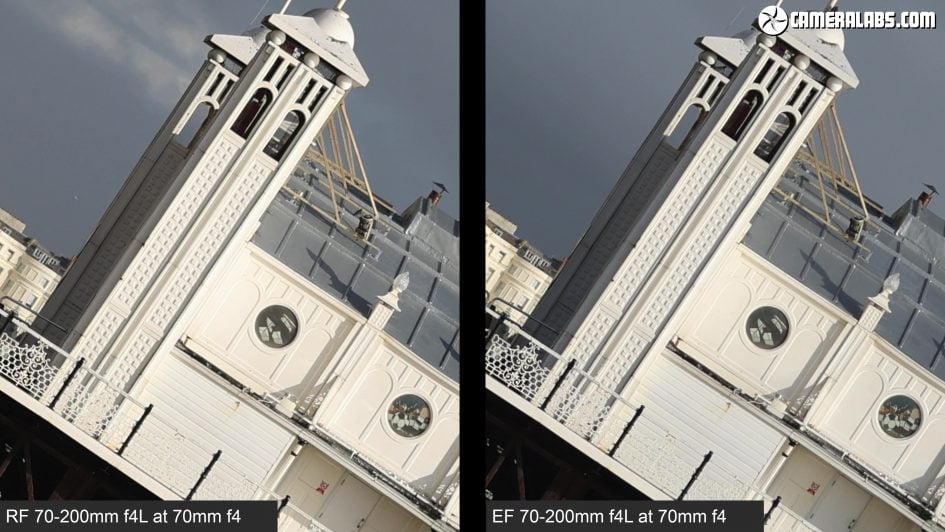
Above: Here’s the RF 70-200 f4 on the left and the EF 70-200mm f4 Mark II on the right, both showing a magnified view of the centre at 70mm f4, where they’re looking pretty similar.
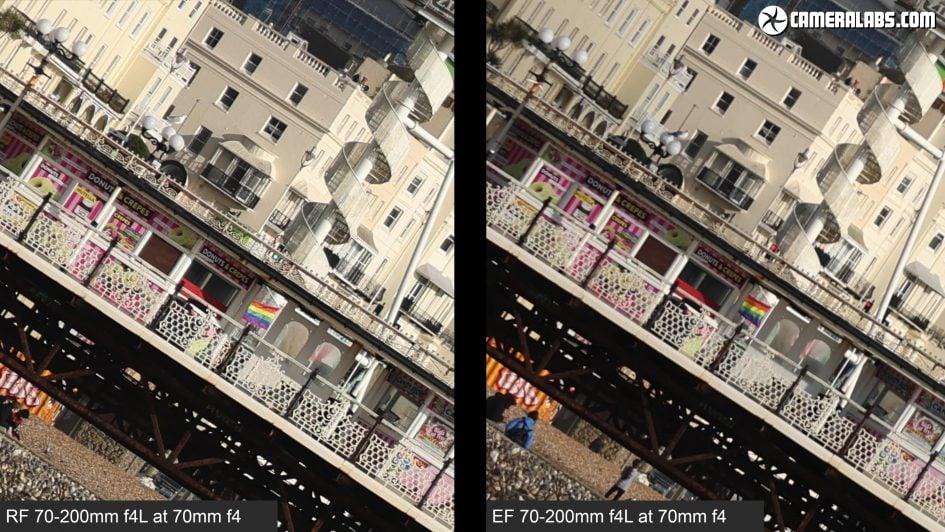
Above: And now to the corner where the RF is a little sharper, but there’s not much in it. Closing the aperture a stop or two makes them pretty much identical in the corner.
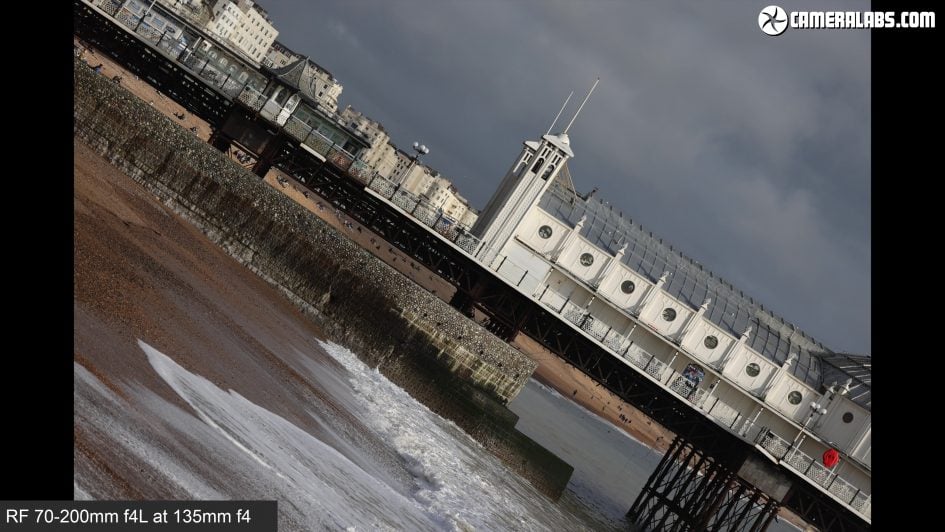
Above: Next up the view at 135mm, starting with the RF 70-200mm f4 which in the middle again looks very sharp with no benefit to stopping-down further. Moving into the corners again reveals the excellent performance of the lens with crisp details at f4 and again little benefit to closing the aperture further.
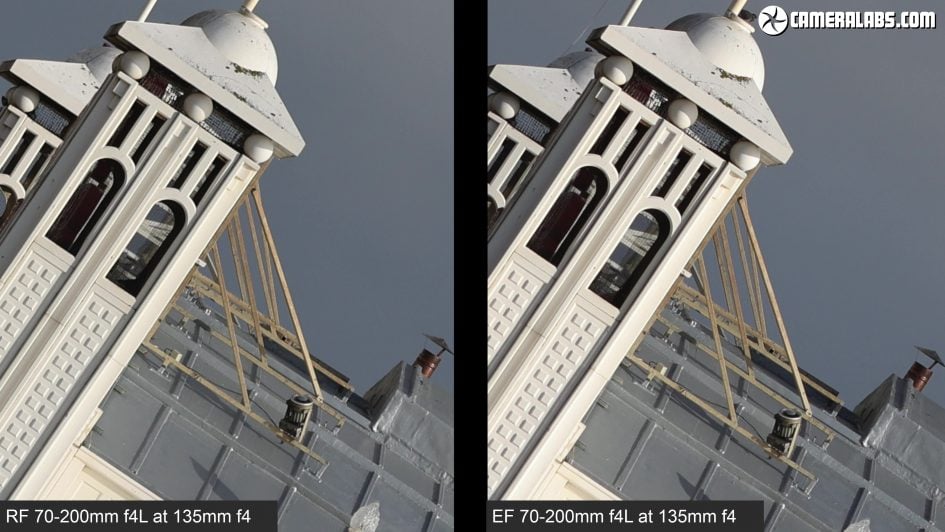
Above: Side by side at 135mm with the RF lens on the left and the EF Mark II on the right, the magnified view of the middle shows them to be pretty much neck in neck, and again neither shows significant improvement when stopped down.
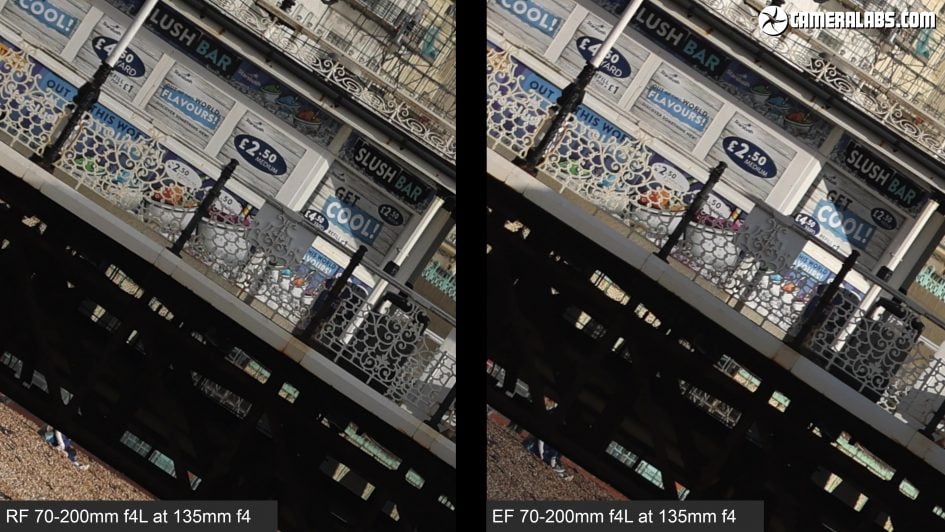
Above: Comparing the far corners and again it’s a very close call. Arguably the RF lens is a fraction sharper, but I wouldn’t complain about the EF performance here, and again if you’re shooting a landscape you could always stop down to f5.6 or f8 to match the quality.
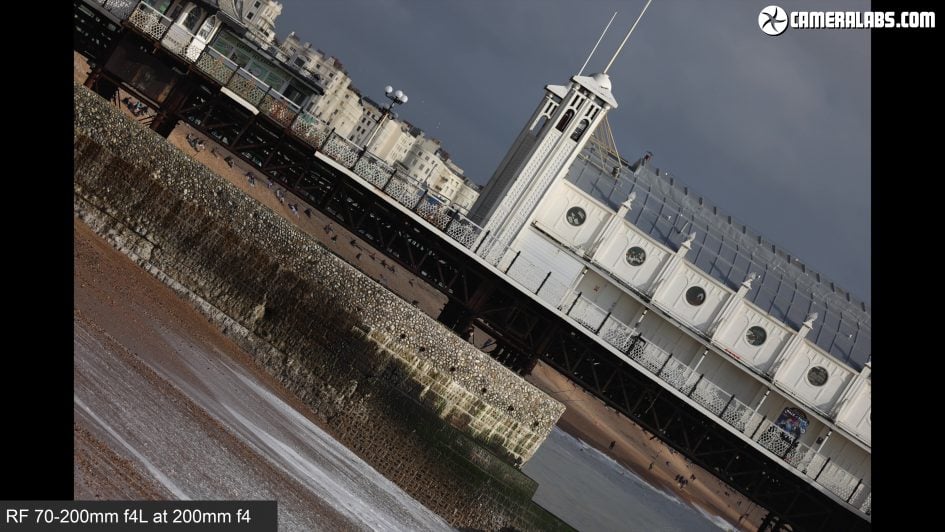
Above: And finally the view at 200mm from the RF 70-200mm f4, and completing a story of excellent performance, you’ll see there’s sharp details in the centre which again don’t benefit from stopping-down, with that crispness extending into the corners. Obviously as a telephoto zoom, the depth of field can become quite shallow, so for landscapes you may prefer to stop-down, but these tests show the lens can perform very well when wide-open.
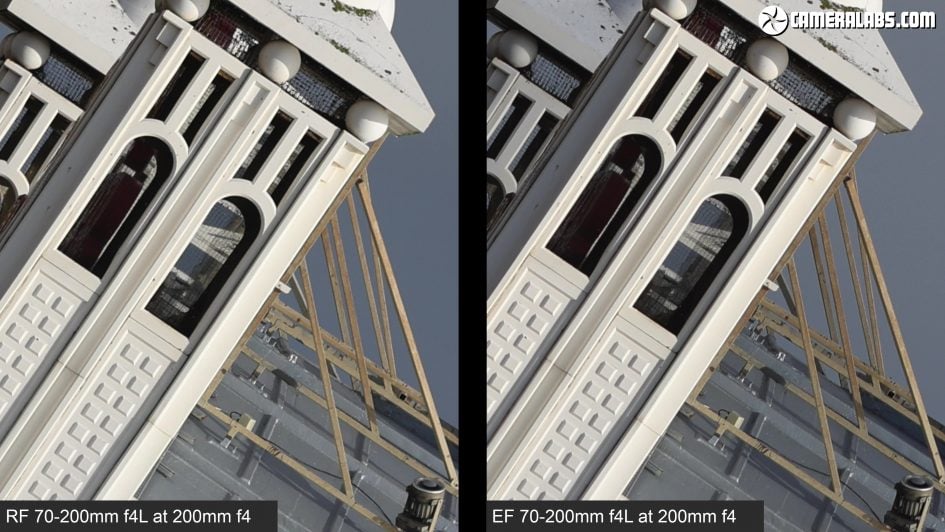
Above: Side by side at 200mm with the RF lens on the left and the EF Mark II on the right shows them both delivering similarly-sharp results in the middle when wide-open, a result that also applies to the corners.
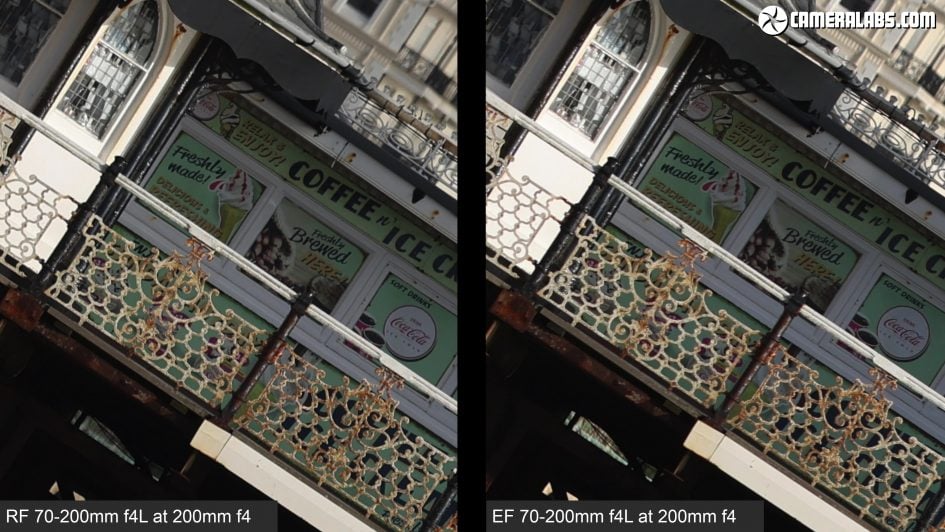
Above: In the corners, the RF is arguably a fraction crisper, but it’s barely visible and I’d be delighted with the detail from either of these lenses.
Check prices on the Canon RF 70-200mm f4L IS USM at B&H, Adorama, WEX or Calumet.de! Alternatively get yourself a copy of my In Camera book or treat me to a coffee! Thanks!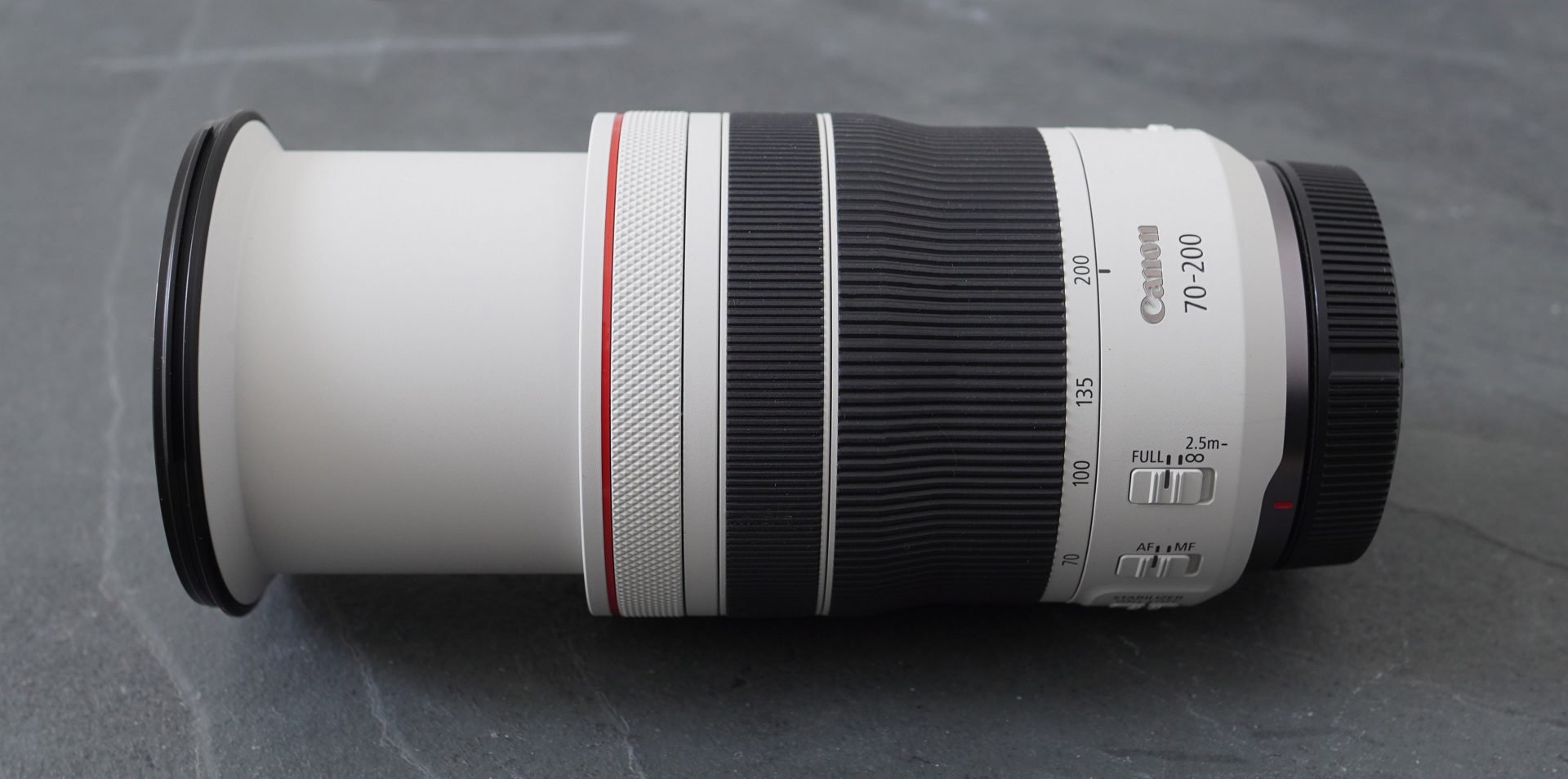
 With the RF 70-200mm f4L, Canon’s once again shown how a new lens can match or exceed the performance of a popular classic while adding something different - in this case a much more compact design, at least when set to 70mm. The new RF version manages to match the most recent EF model at long distances, while becoming slightly sharper at close range for portraits and even more so for macro. In my tests it also proved more consistent and accurate when focusing stills on the R5 than the EF lens, and a little smoother and more confident for video focus too. What makes the RF lens really special though is its size, little larger than a 330ml can when zoomed to 70mm and considerably more portable than the EF version, particularly when the adapter’s fitted for EOS R bodies. The extending barrel is a double-edged sword though as it’s way too soon to know about long-term sealing. Like the RF 2.8 version, the optical design sadly rules out the use of RF teleconverters and also results in significant focus breathing where the magnification reduces at closer focusing distances. Ultimately the older EF 70-200mm f4L Mark II remains an excellent lens and if you already have one, or less to spend, I’d stick with it. But if you don’t already own a 70-200mm f4, the combination of superb optical quality, accurate focusing and a surprisingly compact design makes the RF version highly compelling and worth spending the extra. Event and portrait photographers will love its quality, confidence and portability, and it’s another lens that makes the EOS R system tempting for new buyers.
With the RF 70-200mm f4L, Canon’s once again shown how a new lens can match or exceed the performance of a popular classic while adding something different - in this case a much more compact design, at least when set to 70mm. The new RF version manages to match the most recent EF model at long distances, while becoming slightly sharper at close range for portraits and even more so for macro. In my tests it also proved more consistent and accurate when focusing stills on the R5 than the EF lens, and a little smoother and more confident for video focus too. What makes the RF lens really special though is its size, little larger than a 330ml can when zoomed to 70mm and considerably more portable than the EF version, particularly when the adapter’s fitted for EOS R bodies. The extending barrel is a double-edged sword though as it’s way too soon to know about long-term sealing. Like the RF 2.8 version, the optical design sadly rules out the use of RF teleconverters and also results in significant focus breathing where the magnification reduces at closer focusing distances. Ultimately the older EF 70-200mm f4L Mark II remains an excellent lens and if you already have one, or less to spend, I’d stick with it. But if you don’t already own a 70-200mm f4, the combination of superb optical quality, accurate focusing and a surprisingly compact design makes the RF version highly compelling and worth spending the extra. Event and portrait photographers will love its quality, confidence and portability, and it’s another lens that makes the EOS R system tempting for new buyers.



